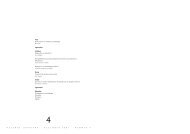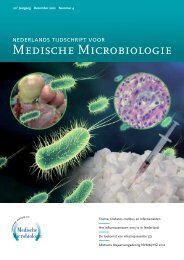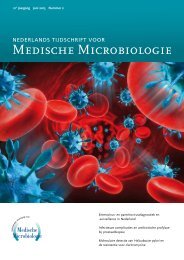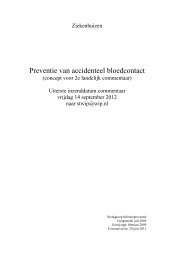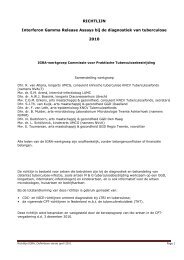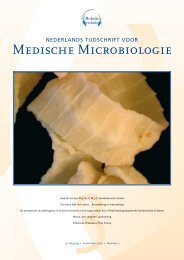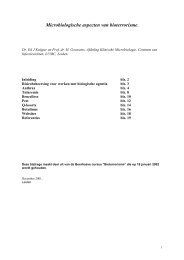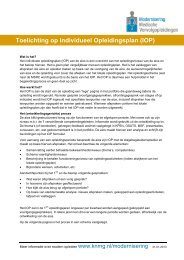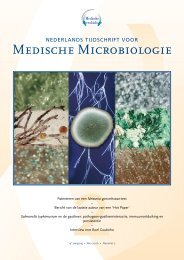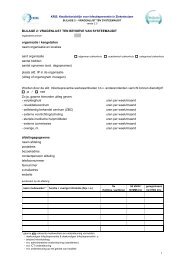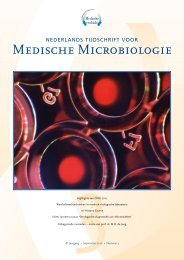Supplement bij veertiende jaargang, april 2006 - NVMM
Supplement bij veertiende jaargang, april 2006 - NVMM
Supplement bij veertiende jaargang, april 2006 - NVMM
Create successful ePaper yourself
Turn your PDF publications into a flip-book with our unique Google optimized e-Paper software.
stress resistance and virulence. Hfq mediates basepairing<br />
between sRNAs and complementary sequences present<br />
in target mRNAs and thus controls gene expression at the<br />
posttranscriptional level.<br />
A hfq homolog is present in the available sequenced<br />
genomes of Neisseria meningitidis, but its riboregulated<br />
network is unknown. The aim of our study is to unravel<br />
this network to identify novel, Hfq dependent, meningococcal<br />
virulence factors, being potentially new targets for<br />
intervention and diagnostics.<br />
A hfq knock-out of N. meningitidis strain H44/76 was<br />
constructed. This knock-out strain is highly sensitive to<br />
exposure to UV light compared to the wild type strain. In<br />
addition, the mutant is severely hampered in growth in<br />
rich media, and does not grow at all under conditions of<br />
iron limitation. Expression of hfq in trans in the knock-out<br />
strain restored growth. Preliminary analysis of proteins<br />
subjected to Hfq regulation, assessed by the comparison<br />
of protein profiles of the knock-out strain and the wild<br />
type strain and peptide mass finger prints, resulted in the<br />
identification of meningococcal components involved in i)<br />
iron-acquisition (major ferric iron binding protein, fbpA), ii)<br />
nitrogen sensing (glnD), iii) protection of the cells against<br />
damage by free radicals (putative oxido-reductases such<br />
as sucA and NMB1796), and components involved in the<br />
assembly of pili and a variety of outer membrane proteins<br />
with unknown functions.<br />
The reduced growth rate and tolerance for stress conditions<br />
of the hfq knock-out strain and the identification of Hfq<br />
regulated genes that encode for components involved in<br />
adaptation to the environment and adherence, strongly<br />
indicates that meningococcal Hfq is involved in the<br />
regulation of the response to environmental stress and<br />
thereby contributes to the virulence of the bacteria.<br />
05.14<br />
Identification of putative surface exposed proteins specific for<br />
hospital adapted vancomycin-resistant Enterococcus faecium<br />
A.P.A. Hendrickx, W. van Wamel, M.J.M. Bonten, R.J.L.<br />
Willems<br />
UMC Utrecht, Eijkman-Winkler Institute for Microbiology,<br />
Department of Internal Medicine, Utrecht<br />
Introduction: The incidence of infections caused by<br />
vancomycin-resistant Enterococcus faecium (Efm) has<br />
dramatically increased in hospitals world wide. The majority<br />
of clinical relevant Efm cluster together by multilocus<br />
sequence typing (MLST) in a hospital-adapted genogroup,<br />
designated clonal complex-17 (CC17). Due to their multiresistant<br />
nature, infections with CC17 Efm are difficult to<br />
treat. The objective of the current study was to identify cell<br />
surface proteins (CSP) that are found enriched in CC17 Efm<br />
Ned Tijdschr Med Microbiol <strong>2006</strong>; 4:<strong>Supplement</strong><br />
S27<br />
and that may serve as targets for immunotherapy to prevent<br />
and treat infections with these bacteria.<br />
Methods: Two approaches were followed to identify CC17<br />
enriched surface proteins; (1) CSP of multiple Efm strains<br />
from CC17 and non-CC17 were covalently labelled with<br />
biotin to detect differences in CSP expression, (2) the<br />
genome of Efm DO (which belongs to CC17), was searched<br />
for genes encoding CSP containing the LPXTG cellwall<br />
anchor motif. Using PCR a set of 100 Efm isolates<br />
belonging to CC17 and other complexes was screened for<br />
the presence of these CSP genes.<br />
Results: Biotin labelling of CSP of CC17 and non-CC17<br />
isolates revealed at least one CSP unique for CC17. The<br />
genome search revealed 16 putative CSP genes and PCR<br />
screening of 100 CC17 and non-CC17 isolates identified<br />
5 CSP genes, which were predominantly found in CC17.<br />
Negative PCRs were confirmed with Southern hybridization.<br />
Clustering based on the presence and absence of<br />
the CSP genes showed a comparable grouping as MLST<br />
suggesting that the clinical relevant strains of CC17 have<br />
an unique profile of putative CSP.<br />
Conclusions: (1) Using biotin labelling one CSP was<br />
identified, which is unique for and highly expressed in<br />
CC17. (2) PCR screening identified 5 putative CSP genes<br />
enriched in CC17 and highly homologous to microbial<br />
surface components recognizing adhesive macromolecules.<br />
These putative CSP could be potential targets for<br />
new treatments to combat the emergence of CC17 Efm.<br />
(3) The distinct CSP profile of CC17 Efm may enhance its<br />
pathogenic potential thus contribute to its success in the<br />
hospital environment.<br />
05.15<br />
Infections of complement resistant and complement<br />
sensitive Borrelia burgdorferi sl in Wildtype and C3 deficient<br />
mice.<br />
N.D. van Burgel1 , N. Balmus 2 , A.P. van Dam 1<br />
1 2 LUMC, Medical Microbiology, Leiden, LUMC, Pathology,<br />
Leiden<br />
Of the different species within Borrelia burgdorferi sensu<br />
lato, B. burgdorferi sensu stricto, Borrelia afzelii and a<br />
subgroup of Borrelia garninii strains show resistance to<br />
complement, whereas other B. garinii strains and Borrelia<br />
valaisiana strains are sensitive. This resistance is due to<br />
binding host factor H through CRASPs (Complement<br />
Regulatory Aquired Surface Proteins). We evaluated in<br />
a murine model whether absence of complement would<br />
influence infectivity and pathogenicity of complementsensitive<br />
and -resistant Borreliae.<br />
Five groups of 3 mice deficient in complement component<br />
C3 (C3KO) and syngeneic C57Bl/6 control mice were<br />
challenged with a pathogenic B. burgdorferi ss. strain



